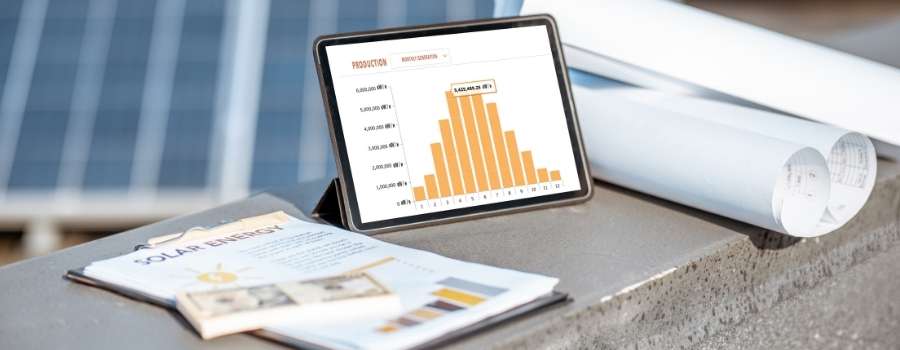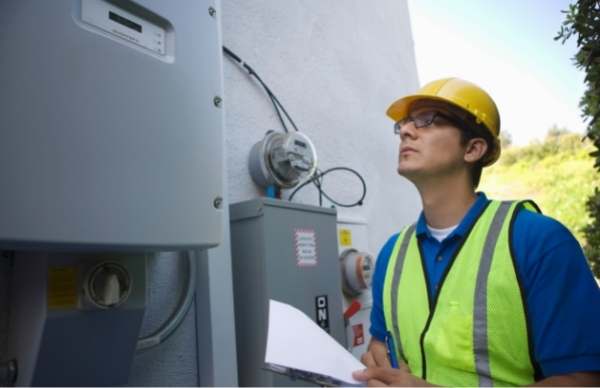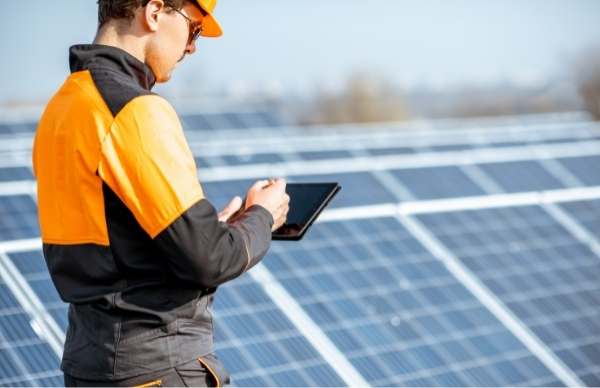Do you have a solar system, but don’t know where to start when it comes to solar monitoring?
Solar monitoring allows custom reports to be created based on the amount of energy a system creates from one platform. This allows users to track the daily production of energy on one dashboard.

While solar monitoring requires little maintenance and demands little effort from the user, they are extremely helpful when trying to understand how much power the solar system generates at different times.
Understanding solar monitoring, how it works, and at what time of day the system produces the most electricity, as well as tracking the amount of energy you use, is extremely important when trying to optimize the performance of a solar energy system.
This guide will help you understand what solar monitoring is, why it exists, the benefits, and where solar monitoring is available to you.
What Is Solar Monitoring?
Solar monitoring allows individuals to track the current and historical solar production of their solar system. They allow for custom reports to be created on one platform, and many allow users to track production from anywhere, at any point from their mobile phones and online platforms.
As your solar system’s inverters or charge controller converts DC electricity to AC electricity, solar monitoring systems convert those power levels into streamlined data customers can look at to get real-time data on how much electricity their systems are producing.
Solar monitoring systems are a fantastic way for users to keep track of the efficiency of their solar panels and the energy production of their solar array. Many solar panel owners find that they have been able to diagnose serious issues with their panels before they became a bigger problem by simply monitoring their energy production!
The information created by solar monitoring is stored and accessed in many different ways. While some solar monitoring systems come with the ability to connect to the internet through Wi-Fi or ethernet, some solar monitoring systems include the ability to access the system through cellular data so that customers can access their information despite internet outages.
The exact functions and methods for solar monitoring will differ depending on which manufacturer you work with, as some solar monitoring systems may be included in your solar equipment when purchasing. Some, however, are sold as an add-on, and sometimes even bought from a different company.

How Do I Monitor My Solar Output?
Users can monitor their solar output by using a solar monitoring system. These may be provided to them when they purchase their solar systems, sold as an add-on when purchasing their solar systems, or a great purchase that will allow them to optimize their solar energy production.
Solar monitoring can be crucial when attempting to understand how much energy your solar systems are creating, and it can also help diagnose serious issues.
Many believe that their power bill is a great reflection of how well their solar system performed. Unfortunately, this is not an accurate way to figure out the total amount of solar energy production done by your solar systems.
Although many electric companies will give customers credit for any surplus solar energy created and fed to the power grid, the number does not reflect the total energy created by the solar systems.
The way customers access the raw data will differ depending on the platform they have, but many of these solar monitoring companies have online portals or apps designed to allow users to access and track their solar production from anywhere, at any time.
Not only that, but they will include real-time numbers and historical data. That means that you can see how your solar systems are performing at that moment compared to how it has performed throughout the time you’ve had them.
Many of the new solar systems today come with monitoring capabilities, and some allow users to sign up for text alerts. These texts can include how their solar systems are doing, to alert warning that their system may not be performing correctly.
Watching your solar panel production can allow for a better understanding of how your solar panels work, at what time they create the most energy, and how much excess power you may be creating, which will be fed into the power grid.
Solar monitoring can also help users keep an eye on the energy production to identify any issues their solar system may be having early as to keep their system healthy and to ensure that they are optimizing their solar system.
If you are looking at your solar monitoring system and find that there has been a decline in solar energy production, there are a couple of things you can do.
- Check the inverters on your solar system- this is one of the top reasons you may be seeing a decrease in energy production on your solar monitoring system. The inverters are what take the solar energy from your solar panels and turns them into energy. If this is not working correctly, it could mean that your system is not producing the maximum amount of energy.
- Shade and dust on panels- If you find that your solar monitoring system is showing a decline in production, your panels may simply be dusty, or in the shade. Your panels work best when directly in the sun’s rays and can be obstructed easily by dust and shade. If this happens, they won’t perform to their maximum potential, which will reflect on your solar monitoring system.
- Check the weather- if you’re out of town and find that your solar monitoring system shows that there has been a decline in solar production, it may be a sign that the weather back at home is less than sunny. If the weather has been cloudy, or there has been a handful of rainy days, you may find that there will be a decrease in production, which will reflect on your solar monitoring system.
Solar monitoring systems are easy to read and provide you with so much amazing information that will always be readily available, whenever you need it.

Why Is Solar Monitoring Important?
Generally, solar monitoring is important because not only does it save the consumer money on their energy bills, but it will also protect you from solar system downtime. Monitoring your solar panels will help solar system owners optimize their energy costs.
As more and more people invest in solar systems, it’s important to have a system that allows those users to access how much solar energy their system is creating, and how it will benefit them.
Solar monitoring allows users to monitor their solar panels from anywhere, even if they’re in another country on vacation. Monitoring their solar systems can help these users optimize and understand the amount they are paying on power, allowing them to adjust the energy they consume at certain times of the day.
Solar monitoring also helps protect customers’ homes. That’s right…solar monitoring can help protect homes against power outages. If anything is wrong with the system, individuals will receive an alert that can help prevent serious issues down the line.
In addition to detecting issues, many solar systems can also help pinpoint the problems a solar system is having and provide repair solutions for the equipment.
Lastly, solar monitoring keeps track of ongoing weather patterns, allowing solar system owners to keep this historical weather data to forecast how the weather may affect their overall energy production, in turn saving them money.

Is It Better To Monitor My Own Solar Output Or Rely On A Company?
In general, most people will want to have their solar output monitored by a company. While you can certainly monitor your output yourself, a company will understand fluctuations and historical data that will help them track issues.
While solar system owners can keep track of the excess power they are generating via their energy bill, it is unlikely that they will be able to get a full picture of exactly how much energy their systems are producing overall.
On top of that, if their solar systems see a decline in production, it is unlikely that solar system owners will have any data provided to them that will easily allow them to pinpoint the issue. This could lead to bigger issues or damage to their solar systems, and a lot of money spent for fixes they don’t need.
The benefits of solar monitoring companies are that their technology will keep historical data for customers to access at any time, and help users save money by reporting problems and directing them to repair solutions.
If a solar system sees a steep decline in production because of a serious issue that must be addressed, likely, they will not know about the issue until it is too late, and even then, if they don’t pay attention to their power bills, they still may not notice it!
Users who do not have a solar monitoring system should try monitoring their solar panels by keeping an eye on their solar inverters. If they do not have solar monitoring through a company, they likely have a string inverter that came with their solar panels.
A string inverter is larger than the micro-inverters attached to individual solar panels. String inverters can be monitored for the number of kilowatt-hours (kWh) of electricity production their system is creating throughout the entire day.
Customers who wish to monitor their solar energy output themselves can keep track of the hourly amount of energy created through their string inverter.
But, unless they keep an hour-by-hour report of the amount of energy created each day, on the hour, and the type of weather they are experiencing, they likely will not get the full picture of how well their solar panels are working during specific points of the day.
Not only that, but they will not experience the benefit of being alerted to any issues their system is experiencing.
How Much Does Solar Monitoring Cost?
Solar monitoring systems provide real-time information about so many aspects of a solar system’s operations and can range in price from $300-$500. However, if you choose a solar manufacturer that provides monitoring as part of their product, the monitoring usually comes at no additional cost.
Keep in mind that these manufacturers may not all offer microinverters that connect to any outside application.
While some may offer monitoring capabilities with a web portal and/or a mobile app that allows users to access their production data from anywhere, some may only support individual module monitoring.
Additionally, while some microinverters may come with a warranty, they may cost more than the initial price of your solar system.
Solar monitoring may also be offered by your solar installer, as many offer monitoring software. That being said, many of these are just the manufacturer’s software with a different look. Some nationwide installers even offer portals that provide you with day-after data, but will not provide you with real-time solar monitoring.
Lastly, there are many solar monitoring solutions available that are created by companies that do not manufacture or install solar panels. These can be a great solution that includes additional product features that can help keep track of energy usage as a whole, which can be much different than the other solar-specific monitoring.
These applications can help track home energy consumption for those with and without solar systems by utilizing AI device profiles. These will show where the most energy is being consumed in the customer’s house at any time.
As these are not provided by the manufacturer and allow users to track their energy consumption in many more ways than other monitors, these devices will usually cost around $300-$500, depending on what the device offers.
Many reports that some of the best solar monitoring systems come from installers, but it’s truly up to the individual, as each system comes with its own benefits.
Final Thoughts
Solar monitoring is one of the most important aspects of solar power systems. By continuously monitoring the solar energy output of your solar systems, you’ll be able to adjust and refine your system to meet your specific wants and needs.
Not only that, but you’ll be able to see how much money your system will save you- an important fact when you consider how much you’ve likely invested into it!
Solar monitoring helps you understand how your system performs best by showing you which conditions and factors allow it to work at its peak performance.

